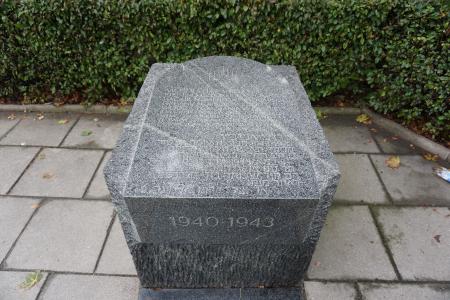Obj. ID: 52492
Modern Jewish Art Memorial Route of Martyrdom and Struggle of Jews in Warsaw - block 10 (Mordechai Anielewicz)
To the main object: Memorial Route of Martyrdom and Struggle of Jews in Warsaw, Poland, 1988

Memorial Name
Trakt Pamięci Męczeństwa i Walki Żydów w Warszawie (Memorial Route of Martyrdom and Struggle of Jews in Warsaw)
Who is Commemorated?
Jewish fighters and victims of the Warsaw Ghetto.
Description:
The monument is part of the Memorial Route of Martyrdom and Struggle of Jews in Warsaw.
The stone block is made of unpolished black syenite. Its upper surface is shaped like a traditional Jewish tombstone and is polished. This surface bears a depiction of a seven-branched menorah and identical Polish and Hebrew inscriptions. The dates 1940–1943, indicating the period of existence of the Warsaw Ghetto, are placed on the front of the block. Polish and Hebrew inscriptions, “Memorial Route of Martyrdom and Struggle of Jews,” are placed on the left and right sides of the block.
The block is situated at the entrance to the Mila 18 Bunker Site (see here).
Inscription:
Polish
Mordechaj Anielewicz
1919-1943, członek Haszomer
Hacair, komendant Żydowskiej
Organizacji Bojowej, przy-
wódca powstania w getcie
8 maja 1943 roku w otoczonym przez
Niemców bunkrze dowództwa wraz
ze swym sztabem
odebrał sobie życie;
odznaczony pośmiertnie Krzyżem
Grunwaldu III klasy
Translation: Mordechai Anielewicz, 1919-1943, member of Hashomer Hatzair, commander of the Jewish Combat Organization, leader of the ghetto uprising; on May 8, 1943, in the command bunker surrounded by Germans, together with his staff, took his own life; posthumously awarded the Grunwald Cross, 3rd class.
Hebrew
מרדכי אנילביץ
1920 – 1943, חבר השומר הצעיר
מפקד הארגון היהודי הלוחם,
מנהיג המרד בגטו וארשה
ב-8 במאי 1943 איבד עצמו לדעת
יחד עם אנשי המפקדה בבונקר
הפיקוד שכותר בידי הגרמנים
לאחר מותו צוין
באות צלב גרונוולד דרגה III
Translation: Mordechai Anielewicz, 1920-1943, member of Hashomer Hatzair, commander of the Jewish Combat Organization, leader of the Warsaw ghetto uprising; on May 8, 1943, took his own life together with the members of the staff in the command bunker that was surrounded by Germans; posthumously awarded the Grunwald Cross, 3rd class.
On the sides of the stone:
1940–1943
Polish
Trakt pamięci
męczeństwa
i walki
Żydów
Translation: Memorial Route of Martyrdom and Struggle of Jews
Hebrew
נתיב הזיכרון
לשואה
ולגבורת
היהודים
Translation: Memorial Route of the Holocaust and Heroism of Jews
Commissioned by
[to be determined]
sub-set tree:
The unveiling of the route took place on April 18, 1988, on the eve of the 45th anniversary of the outbreak of the Warsaw Ghetto Uprising.
The unveiling of the route took place on April 18, 1988, on the eve of the 45th anniversary of the outbreak of the Warsaw Ghetto Uprising.
The history of the monument is described by Kontanty Gebert:
"For the fortieth anniversary of the Uprising, in 1983, the Polish government, in an unprecedented gesture, invited Jewish organizations from all over the world to participate. Just as unprecedented was the call of Marek Edelman, the last surviving member of the Jewish Fighting Organizations command and activist of the then-banned Solidarity Trade Union, for a boycott of the official ceremonies. Edelman's call went largely unheeded, while Solidarity endorsed the unofficial ceremony. Police forcibly prevented trade union participants from laying wreaths at the memorials, outraging local inhabitants, who then joined in the ceremony-turned-demonstration. Thereafter, until the end of martial law, unofficial ceremonies at the memorials became important Polish patriotic events with the mass participation of the Gentile population.
An offshoot of the activities of the dissident group was the creation of a Civic Committee for the Preservation of Jewish Monuments. Having gained official recognition, the Committee decided to build a new Holocaust memorial, breaking with the traditional emphasis on both the Uprising and the de-individualized approach to the Jewish victims who were being commemorated. The project, called the Memorial Route of Jewish Martyrdom and Struggle, designed by architect Hanna Szmalenberg and sculptor Wladyslaw Klamerus, received official approval and was unveiled in 1988, on the forty-fifth anniversary of the Ghetto Uprising.
Its basic idea, based on the format adopted by participants in unofficial ceremonies, consists of nineteen one-meter high, black syenite blocks spread out between the monument and the Umschlagplatz, two commemorative plaques on the buildings that housed the SS headquarters and the Jewish hospital, and a new Umschlagplatz memorial. Each block commemorates an individual connected with the Ghetto, such as the poet Itzhak Katzenelson, Ghetto fighter Frumka Plotnicka, or religious leader Itzhak Nyssenbaum. Walking along this route, which is a kind of "memory lane," passersby can acquaint themselves with the fates of these leaders and thus gain insight into the personal fates of some of the half million Ghetto victims.
This route leads visitors to the new Umschlagplatz memorial, an enclosure in white marble, with a narrow entrance capped by a black bas-relief representing a forest of felled trees. Facing that entrance is a gap in the opposite wall through which a living tree can be seen. On the inner walls of the memorial, several hundred names are engraved — the first names of the Ghetto victims who were deported to Treblinka. The languages used are Polish, Hebrew, and English, but the list of names is only in Polish, for lack of space.
This new memorial merges with the community's real-life, urban surroundings. Its physically and metaphorically human scale, and the shift in emphasis from the heroic resistance of the few to the tragic fate of the hundreds of thousands, enables passersby to experience a personal relationship with those who lived there. Thus, the history of the Warsaw Ghetto has again become connected with the lives of its latter-day inhabitants, re-creating a bond which the former official version of events had all but broken." [Gebert]
Gebert, Kontanty, “The Dialectics of Memory in Poland: Holocaust Memorials in Warsaw,” in James E. Young, The Art of Memory: Holocaust Memorials in History (New York: Jewish Museum, 1994), 121-129.





